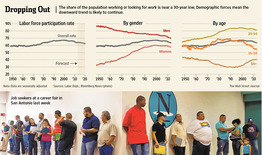
by Ben Casselman
The Outlook column in today’s Journal highlighted how an aging labor force is driving down the share of the population that’s working or looking for work, a measure known as the participation rate. But take a look at the charts accompanying the article, and another story jumps out: The participation rate among older Americans is actually rising.
At first glance, the two trends appear contradictory: If anything, older Americans seem to be driving the participation rate up, not down.
But while it’s true that Americans are working longer, it’s also true that they’re less likely to work than their younger counterparts — and less likely than they were when they were younger. 38% of those over age 55 were working in September, up from just under 34% a decade earlier. But nearly 76% of Americans between ages 45 and 54 are working — meaning they’re twice as likely to be employed.
Put another way: Today’s 55-year-olds are more likely to be working than 55-year-olds were 20 years ago. But an individual 55-year-old man is less likely to be working now than he was when he was 35. (The trend is even more pronounced for women, who flooded into the workforce in the second half of the 20th century.)
That means that the more people we have over age 55, the smaller the share of the population we can expect to be working. And with Baby Boomers now in their 50s and 60s, the over-55 population is growing rapidly.
These same demographic patterns explain what might otherwise be a perplexing trend in the labor market: the surge in employment among older workers. As of September, there were 3.5 million more Americans over age 55 working than when the recession ended in June, 2009. Among the rest of the adult population, employment has actually fallen by around half a million jobs. That might make it look like employers are engaging in reverse age-discrimination, hiring older workers instead of younger ones.
As any older job-seeker can tell you, that isn’t what’s going on. It isn’t that employers are hiring 55-year-olds — it’s that employed 54-year-olds are turning 55. Older Americans account for essentially the entire 8 million person increase in the adult population since the end of the recession. Based on the over-55 employment rate of 38%, we’d expect about 3 million of those 8 million to be working — more or less what we’ve actually seen. Employment trends, in other words, are following expected demographic patterns.
